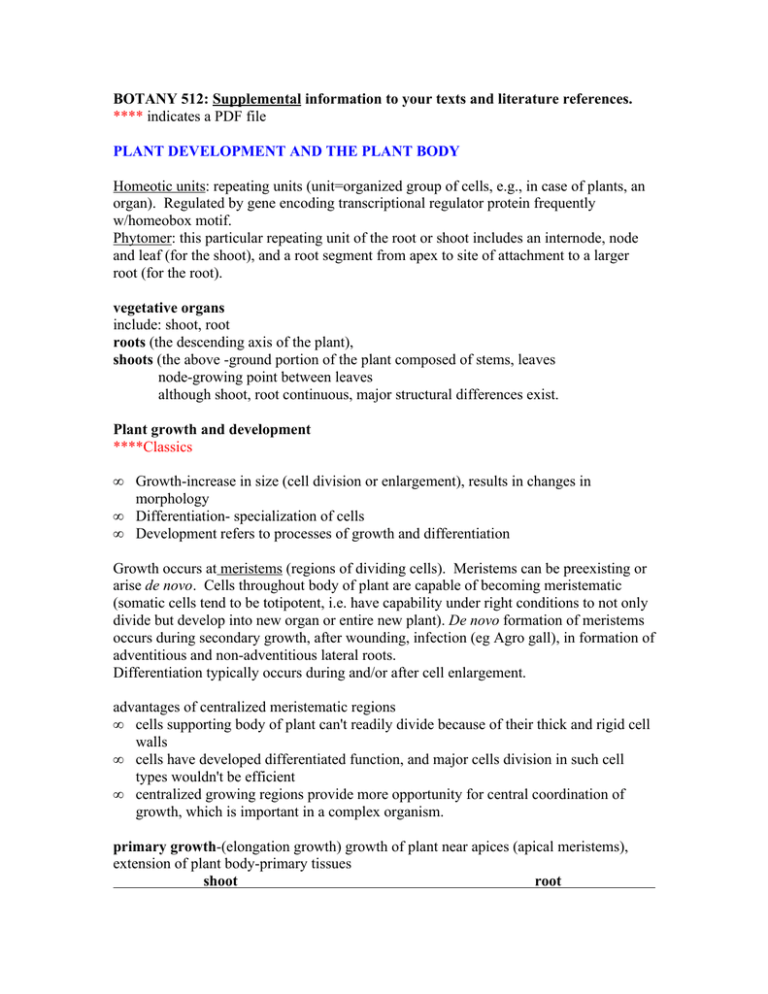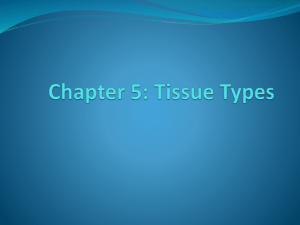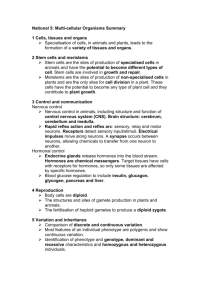BOTANY 512: Supplemental information to your texts and literature references. ****
advertisement

BOTANY 512: Supplemental information to your texts and literature references. **** indicates a PDF file PLANT DEVELOPMENT AND THE PLANT BODY Homeotic units: repeating units (unit=organized group of cells, e.g., in case of plants, an organ). Regulated by gene encoding transcriptional regulator protein frequently w/homeobox motif. Phytomer: this particular repeating unit of the root or shoot includes an internode, node and leaf (for the shoot), and a root segment from apex to site of attachment to a larger root (for the root). vegetative organs include: shoot, root roots (the descending axis of the plant), shoots (the above -ground portion of the plant composed of stems, leaves node-growing point between leaves although shoot, root continuous, major structural differences exist. Plant growth and development ****Classics • • • Growth-increase in size (cell division or enlargement), results in changes in morphology Differentiation- specialization of cells Development refers to processes of growth and differentiation Growth occurs at meristems (regions of dividing cells). Meristems can be preexisting or arise de novo. Cells throughout body of plant are capable of becoming meristematic (somatic cells tend to be totipotent, i.e. have capability under right conditions to not only divide but develop into new organ or entire new plant). De novo formation of meristems occurs during secondary growth, after wounding, infection (eg Agro gall), in formation of adventitious and non-adventitious lateral roots. Differentiation typically occurs during and/or after cell enlargement. advantages of centralized meristematic regions • cells supporting body of plant can't readily divide because of their thick and rigid cell walls • cells have developed differentiated function, and major cells division in such cell types wouldn't be efficient • centralized growing regions provide more opportunity for central coordination of growth, which is important in a complex organism. primary growth-(elongation growth) growth of plant near apices (apical meristems), extension of plant body-primary tissues shoot root emb. pre-formed pre-formed lateral preformed axillary meristems (at leaf base) become active, form new apical meristem form de novo internally (pericycle of root; shoot cortex) secondary growth (growth in girth)-tissues that arise in regions where cell elongation has ceased, increase in diameter of plant (gymnosperms, many dicots) from de novo lateral meristems most research on primary growth and development. Plant development is highly interdependent on environment and developmental stage. Plant development very flexible- (anatomy, morphology, biochemistry) of organ primordia vary. • adventitious roots from stems (maize prop roots) • shoot meristems leaves, stem + more shoot; thorns (Hawthorne);tendrils(bean); inflorescence, tuber (potato) • leaf primordia leaves, needles(cactus), petals, sepals, stamen, pistils, tendrils (pea) • stem cactus body TISSUE SYSTEMS/TISSUES/CELL TYPES organs are composed of tissue systems, which are comprised of tissues tissues comprised of different cell types Transport system-up (water, minerals) and down(photosynthate) key to development of higher plants-enables many forms, upright stature, competition for sunlight. Vascular arrangement is different in root/shoot, and in monocot and dicot; vascular arrangement also changes during development . Meristematic (growing) regions are differently arranged in shot, root. Three basic tissue systems : Tissue systems originate from a common group of cells in the meristem. Each tissue system is comprised of a variety of tissues and cell types. The same cell types frequently exist in more than one tissue or tissue system, the same tissue type sometimes occurs in more than one tissue system. Tissue systems apparent at early stage in embryo development. As plant grows, continually form at the meristems (i.e. the shoot tips and the root tips) meristem procambium-> tissue system tissue vascular tissue system -> xylem** phloem pericycle major cell types fibers, parenchyma, vessel elements/tracheids fiber, parenchyma, sieve elements, companion cells parenchymal endodermis parenchymal ground meristem-> ground tissue system parenchyma parenchymal (cortex) collenchyma collenchymal sclerenchyma sclerenchymal protodermis-> epidermis periderm* dermal tissue system epidermal, trichomes, guard cork+cork cambium *actually originates from ground meristem, protodermal tissues lost during secondary growth **in shoot secondary xylem, phloem, vascular cambium originates partially from ground meristem Vascular tissue system: transport, support a.xylem (water and mineral conduction from root to shoot) tracheary elements (tracheids-found in seedless plants and gymnosperms) also parenchymal cells, fibers( long, slender, organized into strands or bundles. hemp, jute and flax are all fibers. common in wood, paper) b.phloem (photosynthate transported to non-PHS tissues of plant) sieve elements, companion cells, also parenchymal cells, fibers c. pericycle d. endodermis Dermal tissue system: protection, interaction of plant and environment a. epidermis (parenchymal cells, specialized cell types that protect plant, absorb, disperse seeds) b. periderm (replaces epidermis in plants with secondary growth -ie, growth after elongation has completed; the outer portion of bark) Ground tissue system: PHS, storage, support a. parenchymal tissue (metabolically active cells, conduct much of cellular metabolism-PHS, respiration, active transfer of compounds, water food. can divide-so involved in formation of callus at the site of a wound and wound healing. living at maturity. primary walls usually. parenchyma cells, rays b. collenchymal tissue supportive cells with thick but stretchable primary cell wall. living at maturity. elongated. can be found as discrete strands or as continuous cylinders underneath the epidermal tissues of stems or petioles. (celery) elongated cells with unevenly thickened primary walls support young growing tissue cell elongation can continue since primary wall c. sclerenchymal tissue thick, strong, secondary, often lignified cell walls. may be dead at maturity can be found in plants as: fibers- long, slender, organized into strands or bundles. hemp, jute and flax are all fibers. common in wood, paper sclereids-variable shape, tend to be short cells, may branch, found in peach pits, seed coats, nutshells. growth from inner cell out, gritty basileptal-away from apex acropetal-towards apex. PLANT HORMONES (Greek = stimulators) NATURAL, biosynthesized in plants, alter developmental responses at low concentrations. Site of synthesis may be remote from site of action. (hormones are a type of plant growth regulator) PLANT GROWTH REGULATORS Organic compounds, other than nutrients, that, in small amounts, alter developmental processes in plants. Hormone classes: Include cytokinins, gibberellins, auxins, abscisic acid, ethylene, polyamines, salicylic acid, brassinosteroids, jasmonates, polypeptides. Implicated in the regulatory control of a variety of specific processes at the cellular, tissue or plant level. Early studies suggested the following: auxin gibberellin (GA) cytokinin abscisic acid (ABA) ethylene polyamines jasmonic acid salicylic acid polypeptides cell elongation, gravitropism, fruit enlarge axillary bud inhibition, tropisms, delays leaf senescence & ripening,, assimilate partitioning, ethylene synthesis, root growth stem growth, male/female, fruit enlargement cell division, shoot growth dormancy, stress fruit ripening, senescence, abscission adventitious root formation, flowering, release from dormancy embryo development? anthers->ovaries stress stress, thermogenesis stress Perceived signal transduced (signal transduction) to alter development. Questions: 1) Which hormones are in plants 2) What are biosynthetic and catabolic pathways 3) What is tissue and subcellular compartmentation of synthesis, accumulation, catabolism. 4) What are the mechanism for control of metabolism, accumulation and transport 5) What are signal transduction molecules and pathways 6) Which hormone or combination of hormones is responsible for a particular response Why is it difficult to study the role of hormones in the regulation of plant growth and development ? 1 compartmentalization of hormone in cells or organelles 2 hormone levels low, detection difficulties- hormone detection methods vastly improved over past 15 yrs due to improved instrumentation. GCMS-detection. 3 site of biosynthesis and site of action of plant growth regulators may be different. Because the site of action may be specialized cells, located physically within a variety of other cells and tissues. therefore hard to correlate levels of hormone with particular physiological response. 4 regulator may have an effect when applied exogenously, however, this does not mean that the compound normally acts to elicit the same effect in the plant 5 regulator may be applied but may not penetrate or be transported like the endogenous hormone, so doesn't get to site of action. 6 high concentrations of hormones may cause non-physiological effects 7 different tissues, cells, respond differently to same hormone. 8 different processes are sensitive to different levels of hormone, even in same cell. 9 changes in environment, age, alter responses to hormone The complex way in which plants must respond to their ever changing external environment necessitates a variety of controls on development. ****GC-MS Problems of working with biosynthetic pathways for hormones, which represent a minor portion of carbon flux throughout plant, are distinct. Reactions involving intermediates must be detected using radioisotopes or to get sufficient sensitivity. Criteria to demonstrate a step in a pathway is responsible for synthesis of an endogenous compound (Y): 1) precursor X, and compound Y, are endogenous 2) X is applied at an endogenous level 3) X is applied at the time of the maximum endogenous level of X 4) Time intervals are the same as that between the maximum endogenous levels of X, Y. 5) Positive identification of X, Y





